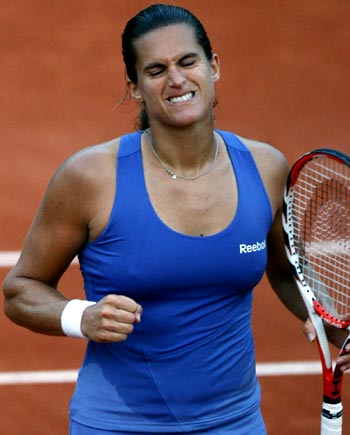

At the 1999 Australian, it was the unseeded, 29th-ranked Mauresmo who caused things to get even spicier than usual. There was nothing dull about women’s tennis at the turn of the century. Sports Illustrated called the eventual finalists, Thomas Enqvist and Yevgeny Kafelnikov, “duller than oatmeal.”
#Amelie mauresmo 2009 full#
The field was full of stars past and future, from Steffi Graf to Monica Seles to Venus Williams.īy comparison, the men’s draw was “the rough equivalent of the jayvee game,” as Harvey Araton put it in the New York Times. Martina Hingis was the defending champion, but she hadn’t won much in the twelve months since. The women’s draw in Melbourne had everything. Mauresmo reached her first major final at the 1999 Australian Open, when she was 19 years old. She knows there will be years when women justifiably monopolize the Roland Garros night sessions. When the roles were reversed, she was one of the women appearing on the front page of the newspaper in the morning and playing on center court at night. That historical context helps explain why Mauresmo was willing to give center stage to one gender over the other. “There have been periods when the women’s game has been more interesting than the men’s but I have to say the women’s game has had a bit of a dip lately.”

With figures like Ashleigh Barty and Serena Williams missing from the women’s side, men such as Novak Djoković and Rafael Nadal were obvious choices for top billing.īBC commentator Annabel Croft defended the schedule. For fans and television schedulers, a handful of famous, veteran names rule the sport. However, few people took issue with Mauresmo’s central argument. It’s a matter of respect balanced programming is key to growing the sport and there are plenty of great women’s matches, like the Alizé Cornet-Jelena Ostapenko clash that did merit the night session.Īll true, as far as it goes. Everyone from Iga Swiatek to Billie Jean King chimed in. The responses to Mauresmo’s comments, of course, were immediate and emotional. It might work, but broadcasters rarely salivate at the prospect of early-round doubles in prime-time.

Mauresmo said that the tournament might address the timing issue by adding a doubles match to the session next year. While plenty of best-of-five men’s matches are boring, too, at least they last a couple of hours. A one-match session could easily turn out to be a dud, especially if a best-of-three contest ended quickly. She said, “In this era we are in right now–and as a woman, a former woman’s player, I don’t feel bad or unfair saying this–you have more attraction and appeal, in general, for the men’s matches.” Most days, the women’s field didn’t offer a “confrontation or star” that would fit the schedule. The event staged one-match night sessions for the first time in its history, and almost every evening of the fortnight, Mauresmo gave that spotlight to men, not women. Plays: Right-handed (one-handed backhand)Īs the new tournament director at the French Open this year, Amélie Mauresmo found herself the inadvertent center of attention. In 2022, I’m counting down the 128 best players of the last century.


 0 kommentar(er)
0 kommentar(er)
